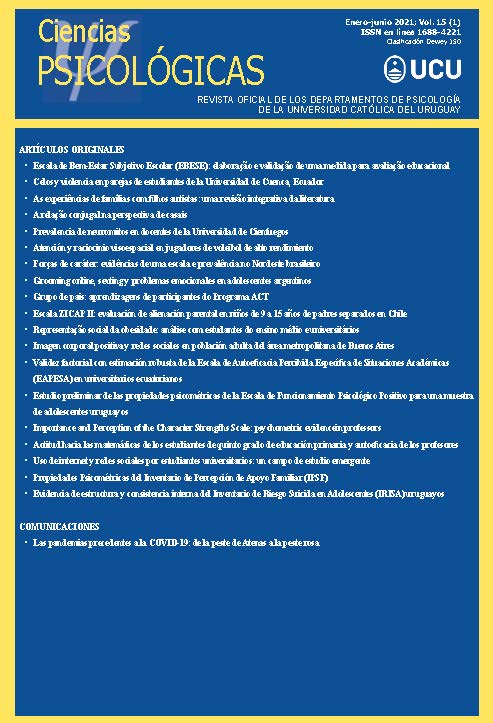Preliminary study of the psychometric properties of the Positive Psychological Functioning Scale in a sample of Uruguayan adolescents
DOI:
https://doi.org/10.22235/cp.v15i1.2396Keywords:
positive psychological functioning, factor analysis, psychometric propertiesAbstract
The objective of this paper was to evaluate the psychometric properties of the Positive Psychological Functioning scale (PPF) in Uruguayan adolescents. The scale is composed of 33 items that measure 11 psychological resources. The PPF constitutes a second-order construct of eudaimonic well-being. An instrumental study was carried out using a convenience sample made up of 183 adolescents (ages 12 through 17) from the general population. The results of the factor analysis carried out had a seven-dimensional structure: self-esteem, autonomy, purpose in life, optimism/enjoyment, curiosity, sense of humor, and environmental mastery (RMSEA = .09, CFI = .99, TLI = .97), and adequate reliability values. The factorial solution organized into seven factors explains 62.15% of the variance. These results coincide with the only published study for an adolescent population, which differs from the original and subsequent studies given that these analyzed samples from university students.
Downloads
References
Alvaro, C., Lyons, R., Warner, G., Hobfoll, S., Martens, P., Labonté, R., & Brown, R. (2010). Conservation of recurces theory and reseach use in health systems implementation. Science, 5(79), 1-20. doi: 10.1186/1748-5908-5-79.
Gaete, V. (2015). Desarrollo psicosocial del adolescente. Revista Chilena de Pediatria, 86(6), 436-443. doi: 10.1016/j.rchipe.2015.07.005.
González, C., Andrade, P., & Jimenez, A. (1997). Recursos psicológicos relacionados con el estres cotidiano en una muestra de adolescentes mexicanos. Salud Mental, 20(1), 27-35.
González, N., Torres, M., González, S., & Ruiz, A. (2018). Propiedades Psicométricas de la escala de Funcionamiento Psicológico Positivbo en Adolescentes. Revista de Psicología de la Universidad Autónoma del Estado de México, 7(14), 80-97.
Hair, J., Anderson, R., Tathan, R., & Black, W. (2004). Analisis Multivariante. Madrid: Perarson.
Hobfoll, S. (1989). Conservation of resources.A new attempt at conceptualizing stress. Americna Psychologist, 44(3), 513-524.
Hobfoll, S. (2002). Social and psychological resources and adaptation. Review of General Psychology, 6(4), 307-324.
Llorente, S., Ferreres, A., Hernández, A., & Tomás, I. (2014). El análisis factorial exploratorio de los items: una guía práctica, revisada y actualizada. Anales de Psicología, 30(3), 1151-1169. doi: 10.6018/analesps.30.3.199361.
Lorenzo-Seva, U., & Ferrando, P. J. (2006). FACTOR: A computer program to fit the exploratory factor analysis model. Behavior Research Methods, 38(1), 88-91. doi: 10.3758/bf03192753
Muthen, B., & Kaplan, D. (1992). A comparison of some methodologies for the factor analysis of non-normal Likert variables: A note on the size of the model British Journal of Mathematical and Statistical Psychology, 45(1), 19-30. doi: 10.1111/j.2044-8317.1992.tb00975.x
Martínez-Arias, M., Hernández-Lloreda, M., & Hernández-Lloreda, M. (2006). Psicometría. Madrid: Alianza.
Merino, D., & Privado, J. (2015). Positive Psychological Funcioning. Evidence for a new construct and its measurement. Anales de Psicología, 31(1), 45-54.
Merino, D., Privado, J., & Gracia, Z. (2015). Validacion Mexicana de la escala de Funcionamiento Psicológico Positivo: perspectivas en torno al estudio del bienestar y su medida. Salud Mental, 38(2), 109-115.
Muratori, M., Zubieta, E., Ubillos, S., González, J., & Bobowik, M. (2015). Felicidad y Bienestar Psicológico:estudio comparativo entre Argentina y España. Psykhe, 1-18 doi: 10.7764/psykhe.24.2.900.
Oliveira, E., Merino, M., Privado, J., & Almeida, L. (2017). Escala de Funcionamento Psicológico Positivo: Adaptação e Estudos Iniciais de Validação em Universitários Portugueses. Revista Iberoamericana de Diagnóstico y Evaluación e AvaliaçãoPsicológica, 3(48), 151-162. doi:10.21865/RIDEP48.3.13.
Padrós, F., & Rivera, M. (2014). Bienestar psicológico, recursos psicológicos y calidad de vida ¿conceptos afines y diferentes? Eurythmie, 1(1), 57-63
Pérez, C. (2004). Técnicas de Análisis Multivariantes de Datos. Aplicaciones con SPSS. Madrid: Pearson.
Rueda, B., & Pérez, A. (2005). Estudio de la competencia percibida procesos de valoración y afrontamiento ante un supuesto problema cardiovascular. Revista de Psicopatologia y Psicologia Clínica, 10(3), 193-204.
Ryff, C. (1989). Beyong ponce de leon and life satisfaction:New directions in quest of successful aging. International Journal of Behavioral Development, 12(1), 35-55.
Timmerman, M. E., & Lorenzo-Seva, U. (2011). Dimensionality assessment of ordered polytomous items with parallel analysis. Psychological Methods, 16(2), 209-220. doi:10.1037/a0023353
Tomyn, A., Weinberg, M., & Cummins, R. (2015). Intervention Efficacy Among "At Risk" Adolescentes: a test of subjetive wellbeing homestasis theory. Social Indicators Research, 120, 883-895.
Vázquez, M., Rivera, M., & Quintanilla, R. (2001). Recursos psicológicos y resiliencia en niños de 6, 8 y 10 años de edad. Revista de educación y desarrollo, 17, 33-41.
Ximénez, M., & García, A. (2005). Comparación de los métodos de estimación de máxima verosimilitud minimos cuadrados no ponderados en el análisis factorial mediante simulación Monte Carlo. Psicothema, 17(3), 528-535.
Downloads
Published
How to Cite
Issue
Section
License
Copyright (c) 2021 Universidad Católica del Uruguay

This work is licensed under a Creative Commons Attribution 4.0 International License.
















